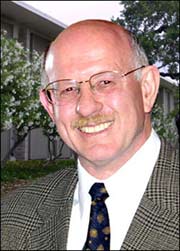
Handy Links
SLAC News Center
SLAC Today
- Subscribe
- Archives: Feb 2006-May 20, 2011
- Archives: May 23, 2011 and later
- Submit Feedback or Story Ideas
- About SLAC Today
SLAC News
Lab News
- Interactions
- Lightsources.org
- ILC NewsLine
- Int'l Science Grid This Week
- Fermilab Today
- Berkeley Lab News
- @brookhaven TODAY
- DOE Pulse
- CERN Courier
- DESY inForm
- US / LHC
SLAC Links
- Emergency
- Safety
- Policy Repository
- Site Entry Form

- Site Maps
- M & O Review
- Computing Status & Calendar
- SLAC Colloquium
- SLACspeak
- SLACspace
- SLAC Logo
- Café Menu
- Flea Market
- Web E-mail
- Marguerite Shuttle
- Discount Commuter Passes
-
Award Reporting Form
- SPIRES
- SciDoc
- Activity Groups
- Library
Stanford
Around the Bay
Dorfan Today: SSRL Annual Shutdown

Last Monday, August 6, marked the beginning of this year's fall shut down for SPEAR3 at the Stanford Synchrotron Radiation Laboratory (SSRL). Next month, SLAC's main linac and the PEP accelerator will follow suit. Accelerator science is constantly evolving, and these annual shutdowns are anything but a time of rest. Maintenance and upgrade periods are essential for ensuring our research facilities remain state-of-the-art.
The 2006-2007 SSRL run ended on a very good note. Of the 5,533 hours of user beam time scheduled, 5,424 hours were delivered for a record 98% uptime. Overall, approximately 1,000 users conducted 1,300 experiments over the course of the last run. This would not have been possible without the focused efforts of the SSRL staff who worked to increase the reliability of the SPEAR3 ring and injector power supplies. Additionally, the injector achieved a big success at the end of the run. Operators kept the injector running until August 9 to establish photoelectrons in the booster, which occurred on Wednesday, August 8.
This year SPEAR3 will undergo a series of upgrades in the continued march toward operation at the design current of 500 milliamps. A number of safety interlock components will be installed in preparation for top-off injection, a necessary step before the increase in current. The insertion device for Beamline 4 will be moved to a new location to facilitate speedy construction of a new 500 mA-ready beamline during the next user run. But the primary activity will be the replacement of most of the booster-to-SPEAR (BTS) transport line which carries new beam from the injector to the storage ring during current refills. This BTS configuration dates back to the very beginning of SPEAR operations in the early 1970s, when SPEAR was filled using the SLAC linac.
Among the most exciting upgrades this fall will be the installation of the new Beamline 13. This new station will be equipped with an elliptically polarized undulator temporarily taken from the present Beamline 5, but ultimately replaced with a new high-performance device during the 2008 shutdown. When it becomes operational over the next year, Beamline 13 will enable scanning transmission x-ray microscopy studies currently unavailable at SSRL.
Congratulations to all who have worked so hard to keep SPEAR running as smoothly as possible. Considering the more than 8,000 papers that have been published based on data from SSRL since beginning operations as a user facility, the continued track record of reliability makes light-source science at SLAC one of our crowning achievements.
—Jonathan Dorfan, SLAC Today, August 13, 2007